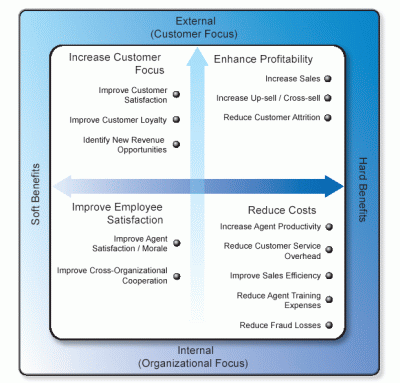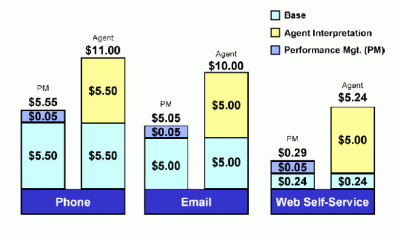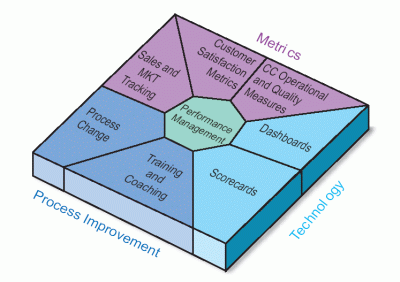
 Every once in a while a new idea or concept comes along that has the potential to change the way we conduct business. Business performance management was conceived to align corporate objectives with the tactical and strategic goals of all operating areas including sales, marketing and customer service. When applied in a contact centre, business performance management shifts the centres orientation from department-centric to enterprise-oriented as it frees managers from the tedious and time-consuming data collection and reporting activities that occupied too much of their time.
Every once in a while a new idea or concept comes along that has the potential to change the way we conduct business. Business performance management was conceived to align corporate objectives with the tactical and strategic goals of all operating areas including sales, marketing and customer service. When applied in a contact centre, business performance management shifts the centres orientation from department-centric to enterprise-oriented as it frees managers from the tedious and time-consuming data collection and reporting activities that occupied too much of their time.
It synchronises the objectives of the executive suite with contact centre management goals and provides tools, processes and a framework for sharing time-sensitive and critical customer information with the rest of the company. And, it achieves these pivotal goals while improving agent productivity and satisfaction.
Aligning Customer Satisfaction and Contact Centre Productivity
The contact centre is the clearinghouse for customer communications as the majority of customer interactions are either initiated by or directed to this organisation. Contact centres are people-intensive and agent-related expenses account for 70 per cent to 80 per cent of their total cost. As a result, since the mid-1970s when phone/call centres were first introduced, their management mantra has been do more with less.
Improving agent productivity was and remains a primary objective, so much so that managers dedicate the majority of their day to meeting internal productivity-oriented metrics, including percent of calls answered within X seconds, average speed of answer (ASA), percent abandonment, calls per agent and agent average handle time.
While contact centre productivity is important, its a costly mistake to prioritise it over customer needs, corporate objectives and image, customer loyalty and service quality. Since its 8 to 10 times more expensive to acquire a customer than it is to retain one, according to Gartner, the service organisation should be positioned to deliver an outstanding experience for each and every customer.
This was difficult in the past, but the introduction of business performance management to the contact centre environment now makes it an achievable goal.
What is Business Performance Management?
 The contact centre is pivotal in identifying problems and opportunities for all parts of a company. Business performance management extends performance management systems, techniques and processes outward from the contact centre to the rest of the enterprise. It collects data from customer interactions (inquiries, complaints, product suggestions and service recommendations), reveals embedded insights and converts them into actions that impact the performance of all departments.
The contact centre is pivotal in identifying problems and opportunities for all parts of a company. Business performance management extends performance management systems, techniques and processes outward from the contact centre to the rest of the enterprise. It collects data from customer interactions (inquiries, complaints, product suggestions and service recommendations), reveals embedded insights and converts them into actions that impact the performance of all departments.
Strategically, it aligns the objectives of the sales, marketing and service organisations with executive decision makers, finance, legal, operations and R&D. Tactically, it includes key performance indicators (KPIs) that measure and track all customer behaviour and outcomes that influence the corporations bottom line.
Performance Management Architecture
Performance management systems are quintessential data collectors. These applications must be open and flexible, able to gather data from many feeder systems located in multiple sites without forcing corporate users to invest in major integration initiatives. The systems must come with application programming interfaces/software development kits (APIs/SDKs) and integration maps to facilitate system and data integration and must include a wizard-based (drag and drop) environment to build additional integrations.
Performance management systems must:
1. Be standards-based, using web services and extensible markup language (XML) to facilitate integration with current and future systems throughout the company. These applications must be non-proprietary, open and flexible.
2. Integrate easily with numerous source systems including automatic call distributor (ACD), computer telephony integration (CTI), customer relationship management (CRM), recording, quality management (QM), workforce management (WFM).
3. Contain a centralised data repository able to handle large volumes of transactions and diverse data from multiple sources.
4. Have a rules engine that allows companies to define the rules of engagement for all feeder systems and reporting mechanisms. The application should facilitate event and report scheduling, select the analysis to be performed as well as algorithms and scoring.
5. Provide reporting packages with standard and custom reporting capabilities.
6. Offer analytics and an online analytical processing (OLAP) engine to facilitate the analysis of information collected from feeder systems.
7. Be flexible and provide customized views tailored to the needs of each user accessing the system in any part of the organisation.
Performance Management Objectives
 Performance management software gives contact centres a framework for overseeing all internal operations. This includes reports reflecting how well individual agents, groups and sites deliver relative to their individual and group KPIs. Performance management differs from individual systems reports from ACD, QM and WFM applications in that it takes a consolidated view that reflects all aspects of an agents behaviour and its impact.
Performance management software gives contact centres a framework for overseeing all internal operations. This includes reports reflecting how well individual agents, groups and sites deliver relative to their individual and group KPIs. Performance management differs from individual systems reports from ACD, QM and WFM applications in that it takes a consolidated view that reflects all aspects of an agents behaviour and its impact.
With traditional reporting methods, agents could be made aware of how well they did on a productivity basis (average talk time (ATT), calls/hour, first call resolution rates), how well they did in their quality ratings and how much they sold. But without performance management they could not see the combined impact of their performance on customer satisfaction, quality, productivity and corporate objectives.
Mixed messages from traditional performance measures frequently frustrated agents striving to meet one set of goals at the expense of another. The result was often poor service and high agent turnover. Performance management takes a 360-degree view of the entire contact centre operation and reflects each agents, supervisors and managers contribution to its success.
Performance management examines a variety of KPIs such as call duration, transfers, quality scores, customer and agent stress levels, key words/phrases (e.g., competitor names) and uncovers statistics outside the norm in each category. Once exceptional behaviour is identified, whether good or bad, its root cause can be analysed by replaying the phone call and screen.
This information can then be used for agent training, to alert sales and marketing and gain a competitive advantage. It can also be used to identify outstanding agent performance that should be rewarded and emulated.
Because they are tied into operational systems outside the contact centre (such as sales and profit systems), performance management applications are also increasingly adept at reflecting how well contact centres contribute to company-wide goals.
Customer service is critical to the success of any enterprise but its value and contributions increase when service goals are aligned with corporate objectives and measured and reported on a timely basis. Good service is a strategic differentiator, but excellent service complemented by knowledge about how best to focus service resources makes an even bigger difference, especially for early adopters.
The more advanced performance management systems go beyond data capture, measurement and recommendations into the interpretation and analysis of customer interactions via call categorisation, word spotting and emotion detection. As more than 95 per cent of information that flows though contact centres is unstructured (phone conversations and emails, for example), capturing, interpreting, harnessing and leveraging this information is a challenge that, until very recently, has eluded contact centres.
Consider the power derived from information included in unstructured, free-flowing customer conversations and email streams. Particularly when customers initiate a sales or service transaction, they freely share highly valuable information about their needs and wants.
Until very recently this data was wasted as contact centre agents, pushed to meet productivity goals, were forced to ignore it and move on to the next transaction. Now, this information can be captured, structured, analysed and put to use, without wasting precious agent resources on its translation and structuring, giving corporate decision
makers a window into the minds of their customers.
Using performance management, agents will know from a corporate perspective what information should be acted upon and will be rewarded for meeting a complex set of objectives. If an agent wins a new customer or retains an old one by spending two to three times the standard time on a call, the corporate benefits will far exceed the costs.
Agents should be rewarded for their initiative, instead of penalized for missing a productivity goal, as they were in the past. Everybody wins the enterprise, the contact centre, the agent and the customer!
Core Performance Management Functionality
The core functional components of performance management suites are:
 1. Scorecards reflect how well different agents, groups or departments are adhering to and delivering toward individual, departmental and corporate goals. For example, an agent scorecard will measure productivity, customer satisfaction, quality, schedule adherence and sales goals (up-sell/cross-sell or new customers).
1. Scorecards reflect how well different agents, groups or departments are adhering to and delivering toward individual, departmental and corporate goals. For example, an agent scorecard will measure productivity, customer satisfaction, quality, schedule adherence and sales goals (up-sell/cross-sell or new customers).
A second set of scorecards will measure the effectiveness of a new sales campaign it may measure which sales pitches are most effective, allowing an enterprise to make quick changes that yield the highest sales. The value of the comprehensive KPIs that reflect productivity, quality, sales and stress levels are much greater than separate reports from different systems.
For example, an agent who has a low call duration and stress level may have been rewarded in the past for high productivity when, in fact, service quality and customer satisfaction were poor, resulting in lost customers and revenue.
2. Dashboards measure individual, group or departmental performance and provide information unique to each users needs, allowing an organisation to take action to improve the customer experience, enhance effectiveness and reduce operating costs. For example, a poorly designed marketing campaign results in a surge in angry customer calls.
This, in turn, significantly increases agent stress levels. The marketing dashboard will pick up patterns of increased customer and agent stress coinciding with the new campaign.
By quickly identifying stress levels that exceed the norm, the marketing organisation is able to get to the root cause and take prompt action to fix the campaign. The feedback from the contact centre allows the company to convert a bad marketing programme into a winning campaign.
3. Content/event analysis engine ability to structure, find the intents and take action on unstructured customer phone conversations. It uses a variety of technologies including: call categorization, word spotting, emotion detection and talk over analysis. Once the customer data is analysed and structured, it can be used to add value to the current transaction, identify future opportunities or facilitate problem avoidance.
For example, agent talk over has been found to increase after agents have been on the phone for more than three consecutive hours without a break. When a 15-minute break is introduced after the second hour, agent talk over dramatically decreases, improving customer satisfaction and contact centre productivity.
4. Action engine automatically identifies and assigns the right action to optimise an opportunity or fix a problem. Action engines advise supervisors when agents are outside normal operational parameters and assign a corrective program. For example, new agents who exhibit patterns of excessive talk time and call transfers should be retrained as the combination indicates a lack of product knowledge.
Action engines identify and assign training courses, offer effective up-sell opportunities, assign marketing scripts and function as an early warning system for an enterprise by quickly noting trends and issuing alerts.
The Benefits
Performance management is action oriented and drives short and long-term changes throughout a corporation. Contact centres are the focal points of customer interactions with companies and performance management systems allow these departments to capture and analyse both structured and unstructured transactions, evaluate them and take actions that immediately benefit a corporation, its customers and its employees.
Performance management systems can and should be used by contact centres to improve performance, but the value increases exponentially when the captured information is assessed and shared with relevant departments throughout the corporation.
Contact centres are expected to sales and solve customer problems this is what theyve done for most of the past 30 years but new performance management tools empower them to extend their value beyond their departmental boundaries by processing and sharing valuable customer information with decision makers throughout the company.
Contact centres are great at understanding customer insights and needs, identifying competitive threats, communicating operational challenges that are detrimental to the bottom line and knowing which customers are about to close their accounts.
Performance management provides the tools for packaging and sharing this time-sensitive customer information so that it translates into actionable recommendations for corporate decision makers.
Sales and Marketing Benefits
Sales and marketing organisations are under a great deal of pressure to improve campaign response and sales rates. These departments are encountering decreasing response rates from phone, mail and email campaigns (3 per cent is now considered outstanding for a typical retail campaign).
Very recently new Do Not Call legislation has further limited their ability to reach out to customers and new prospects. Sales and marketing organisations need access to the treasure trove of customer information gathered in contact centres but have not been very successful because using agents to capture, structure, analyse and organise customer requests would easily cost millions during a year as it would double or triple the handling cost of each transaction.
Payback
Performance management applications that use word spotting and call categorization technologies to interpret customer needs give sales and marketing a window into the previously impervious contact centre world, without incurring agent-related expenses. If a contact centre is able to improve its sales closure rate by only 1 percent on a new campaign mailed to 1 million prospects, at a lifetime value of only $50.00, the incremental benefit to the enterprise will be half a million dollars.
Looking at it this way, the payback from performance management software comes in less than one campaign, contributing to the bottom line within months and improving customer satisfaction in the entire delivery chain, not just the service organisation.
Trends Driving Adoption
Performance management is migrating from a nice to have feature to an essential component of all contact centres. Its quickly becoming a critical differentiator because it automates many of the manual reporting tasks that previously took up more than half of a contact centre managers time, freeing him/her to work towards corporate objectives with sales, marketing and operations. There are many trends driving the adoption of performance management but the primary ones are:
1. Cost reduction Each year, profit and cost centres are pressured to operate more productively. Performance management software pinpoints and prioritises changes and operational enhancements that can improve corporate performance and productivity while enhancing customer loyalty and satisfaction.
2. Alignment of contact centre goals with corporate objectives For most of the past 30 years, a primary function of the contact centre was to keep complaining customers away from corporate decision makers. To achieve this goal, contact centre priorities were often different from and sometimes in conflict with sales and marketing objectives.
Performance management functions as an equaliser, standardising goals among sales, marketing and customer service, improving corporate performance and profitability and increasing customer satisfaction.
3. Providing visibility into customer behaviour, insights and needs Driven by the need to improve their own performance, sales, marketing, research and development (R&D), legal, risk management, auditing and other corporate functions are looking to better understand customer behaviour. Performance management provides a means of opening and sharing contact centre interactions, customer feedback, issues and trends with the rest of the enterprise on a timely basis.
4. Improved communication between sales, marketing and service The goals of these organisations have frequently been in conflict, which is very costly for enterprises. The performance management process establishes common objectives for all customer-facing organisations and by doing so, eliminates some of the conflict by finding common ground. This results in improved efficiency and consequently increased revenue.
5. Reduction of contact centre management time dedicated to reporting A technologically advanced contact centre will use more than 25 systems. While most have sound reporting environments, they generally require manual intervention and manipulation to gain a complete view of the contact centres performance.
Performance management automates many manual activities and frees contact centre managers to concentrate on shared corporate objectives.
Making Performance Management Work
Performance management was conceived to assist companies in modifying behaviour at individual, departmental and corporate levels. It is a solution that facilitates changes in people and process but must be institutionalised and adopted as part of the corporate culture to be successful.
Getting Started
Deciding what needs to be measured (KPIs), defining goals and determining who needs access to various data categories are the first steps in getting started with performance management. Once the reporting requirements are defined, the next step is to determine the appropriate feeder systems (ACD, interactive voice response (IVR), CRM, WFM, QM, etc.) and then its time to build the interfaces.
Reporting has taken on a life of its own in many companies. In the old days when paper was the primary reporting device, the systems group would periodically stop delivering some reports to see if they were still needed. If a department complained, the report was needed. If no one noticed, after a while, they stopped printing the report.
Innovation has eliminated the need for the majority of the paper but not for the review process itself. Its estimated that 25 per cent – 40 per cent of corporate reporting doesnt add value to an organisation and may simply be a waste
of resources.
So, when beginning a performance management implementation, take the time to determine which information is required before automating any existing reporting processes.
Conclusion
Business performance management enables all departments in a company to work in tandem with resulting benefits for customers, employees and the corporations bottom line.
Performance management begins in the contact centre where it collects, analyses and synthesizes a variety of KPIs to create a comprehensive view of the impact of customer interactions and agent performance on departmental and corporate goals.
The combined data enables corporate decision makers to quickly identify the root causes of sales, marketing and servicing challenges in order to take corrective action immediately.
Performance management opens previously untapped resources – customer insights, trends and behaviours – to corporate decision makers in a cost-effective manner, decreasing expenses, increasing revenue and enhancing customer loyalty and satisfaction.
Donna Fluss
Donna Fluss is the Principal of DMG Consulting LLC, delivering customer-focused business strategy, operations and technology for Global 2000 and emerging companies. Ms. Fluss is a recognized leader and visionary in customer relationship management and a highly sought-after writer and speaker. She is the author of the new, industry-leading 2004 Quality Management/Liability Recording Product and Market report. Contact Ms. Fluss at donna.fluss@dmgconsult.com.
Performance Management

